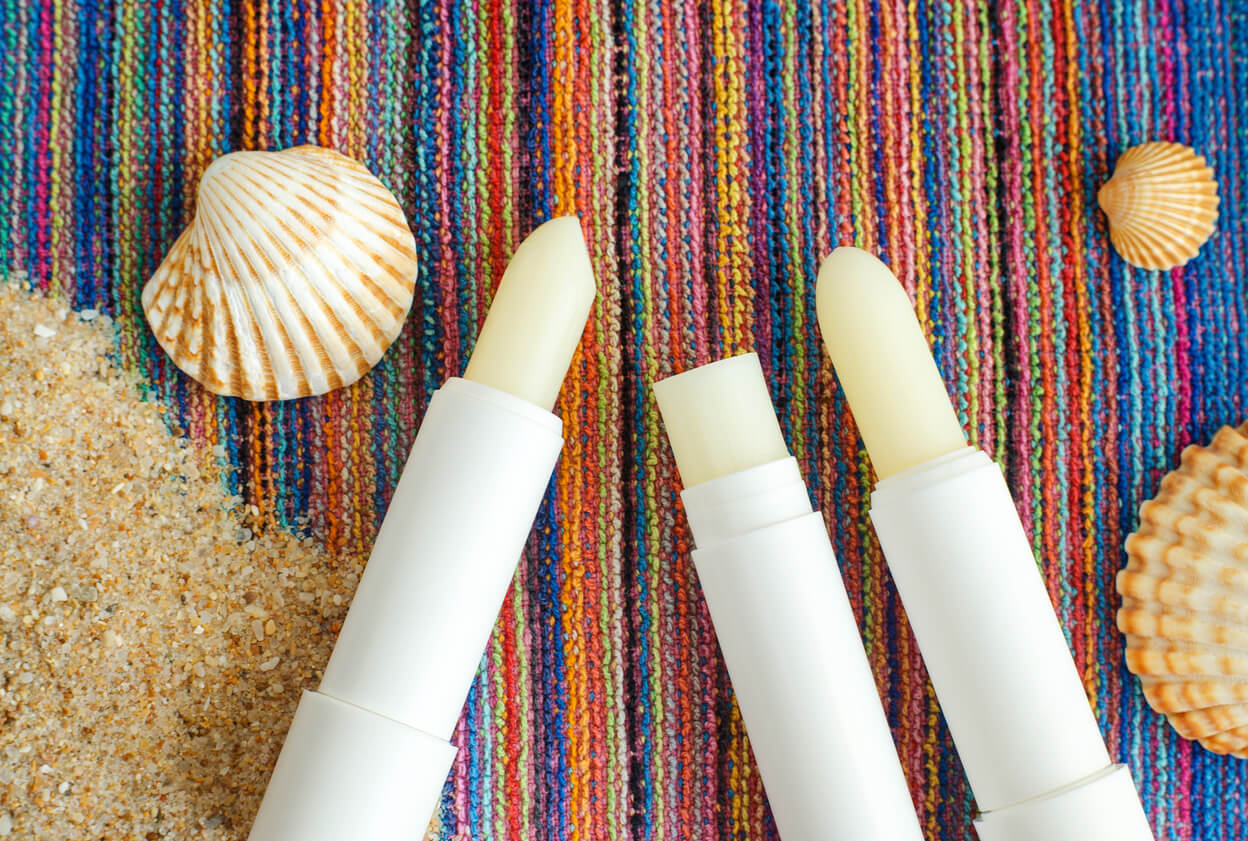10 Common Mistakes When Putting Sunscreen on Children

Some people tend to make certain mistakes when putting sunscreen on children and should know the extent of these mistakes.
This product has become one of the most important cosmetics for daily use, as it’s an essential element to prevent damage caused by the sun’s rays.
To make the most of this protection, don’t miss all the tips we have to offer you.
The most frequent mistakes when putting sunscreen on children
The use of sunscreens is one of the main strategies for the prevention and treatment of skin diseases. Its ultraviolet (UV) blocking action prevents skin aging, sunburn, and skin cancer.
However, when mistakes are made at the time of application, the effectiveness of the product decreases considerably. Here are the most common mistakes and how to avoid them.
1. Applying the wrong amount
To obtain the desired level of sun protection, it’s essential that you apply the correct dosage, i.e. 2 mg per cm2 of exposed skin, which is equivalent to 6 teaspoons for an average body.
If not enough is applied, the sun protection factor (SPF) of the product decreases exponentially. Therefore, the best way to reap the benefits of sunscreens is to use them properly.

2. Forgetting some parts of the body
Some areas of the body aren’t usually taken into account when applying sunscreen:
- Lips
- Eyelids and eyebrows
- Ears
- Back of the neck
- Scalp
- Feet
- Armpits
It should be noted that hair has a protective and temperature-regulating function on the head. Therefore, those with thinning or short hair are more vulnerable to scalp burns.
3. Not choosing the right sunscreen
It’s essential to check that the sunscreen you use protects the skin against a broad spectrum of UV radiation. UVA radiation is the main cause of photoaging, while UVB is associated with sunburn and skin cancer.
Another key point is to know if the product is water resistant.
Don’t rely on the belief that a sunscreen with SPF 15 is more than enough. Nowadays, experts recommend that products have SPF 50 or higher.
You may be interested in: The Best Sunscreens for Babies and Children
4. Putting it on the skin at the time of sun exposure
Sunscreens should be applied on the body and face at least half an hour before exposure to the sun’s rays. This is because they take time to be absorbed and, therefore, the skin remains exposed without the necessary protection for a few minutes.
In addition to this precaution, it’s essential to reapply the product every two hours or sooner if there’s rubbing with the towel, intense exercise is performed, or the skin is wet (after sweating a lot or during swimming).
5. Believing that on cloudy days, it’s not necessary to put sunscreen on children
There are different ways to expose yourself to the sun’s rays, such as outdoor sports, a simple walk during the day, or eating on a deck.
UVA radiation has the ability to pass through clouds, umbrellas, and glass. It also reflects off water and sand.
It’s therefore important to apply sunscreen every day, even in cloudy weather and even when you’re under an umbrella. This is because 90% of UV rays penetrate clouds all year round.
6. Forgetting to apply it after two hours
In general, it’s advisable to apply sunscreen at least 3o minutes before direct sun exposure. Once outdoors, reapply at least every two hours to maintain the protective effects of the product. Even lipsticks or lip creams containing sunscreens should also be applied quite frequently, especially if you’re drinking or eating.
7. Using the same sunscreen on the body and face
There are various formulas on the market designed for all skin types (dry, oily, or combination) and for different areas of the body. This is because facial skin is more sensitive and requires specific components that don’t produce irritation or aggression.

8. Applying perfume before sun exposure
Perfume can cause certain allergic reactions when combined with sun exposure. In addition, there’s a risk of developing spots on photo-exposed areas.
In fact, children’s sunscreens don’t usually contain perfumes in order to reduce the risk of contact dermatitis.
Read also: Apply Sunscreen for Moles and Freckles
9. Using sunscreens from previous summers
Sunscreens have an expiration date like any other cosmetic product. In fact, if the expiration date has expired or the smell and color have changed, you should stop using it.
This is because its function is reduced and there’s a greater likelihood of dermatological problems with use.
10. Believing that wet T-shirts protect skin from the sun
There is a myth that when children are in the water with a regular T-shirt on, they don’t need sunscreen. This is clearly not the case. Nowadays, specific fabrics are marketed that have sun protection factors.
Clothing should have the acronym UPF (Ultra Violet Protection) on the label, accompanied by the number of the protection factor it has.
The importance of correcting mistakes when putting sunscreen on children
Applying sunscreen correctly not only delays the signs of skin aging, but also the development of diseases related to ultraviolet radiation.
In addition to reinforcing protection, it’s also advisable to maintain proper hydration and use clothing that covers as much of the skin surface as possible.
Some people tend to make certain mistakes when putting sunscreen on children and should know the extent of these mistakes.
This product has become one of the most important cosmetics for daily use, as it’s an essential element to prevent damage caused by the sun’s rays.
To make the most of this protection, don’t miss all the tips we have to offer you.
The most frequent mistakes when putting sunscreen on children
The use of sunscreens is one of the main strategies for the prevention and treatment of skin diseases. Its ultraviolet (UV) blocking action prevents skin aging, sunburn, and skin cancer.
However, when mistakes are made at the time of application, the effectiveness of the product decreases considerably. Here are the most common mistakes and how to avoid them.
1. Applying the wrong amount
To obtain the desired level of sun protection, it’s essential that you apply the correct dosage, i.e. 2 mg per cm2 of exposed skin, which is equivalent to 6 teaspoons for an average body.
If not enough is applied, the sun protection factor (SPF) of the product decreases exponentially. Therefore, the best way to reap the benefits of sunscreens is to use them properly.

2. Forgetting some parts of the body
Some areas of the body aren’t usually taken into account when applying sunscreen:
- Lips
- Eyelids and eyebrows
- Ears
- Back of the neck
- Scalp
- Feet
- Armpits
It should be noted that hair has a protective and temperature-regulating function on the head. Therefore, those with thinning or short hair are more vulnerable to scalp burns.
3. Not choosing the right sunscreen
It’s essential to check that the sunscreen you use protects the skin against a broad spectrum of UV radiation. UVA radiation is the main cause of photoaging, while UVB is associated with sunburn and skin cancer.
Another key point is to know if the product is water resistant.
Don’t rely on the belief that a sunscreen with SPF 15 is more than enough. Nowadays, experts recommend that products have SPF 50 or higher.
You may be interested in: The Best Sunscreens for Babies and Children
4. Putting it on the skin at the time of sun exposure
Sunscreens should be applied on the body and face at least half an hour before exposure to the sun’s rays. This is because they take time to be absorbed and, therefore, the skin remains exposed without the necessary protection for a few minutes.
In addition to this precaution, it’s essential to reapply the product every two hours or sooner if there’s rubbing with the towel, intense exercise is performed, or the skin is wet (after sweating a lot or during swimming).
5. Believing that on cloudy days, it’s not necessary to put sunscreen on children
There are different ways to expose yourself to the sun’s rays, such as outdoor sports, a simple walk during the day, or eating on a deck.
UVA radiation has the ability to pass through clouds, umbrellas, and glass. It also reflects off water and sand.
It’s therefore important to apply sunscreen every day, even in cloudy weather and even when you’re under an umbrella. This is because 90% of UV rays penetrate clouds all year round.
6. Forgetting to apply it after two hours
In general, it’s advisable to apply sunscreen at least 3o minutes before direct sun exposure. Once outdoors, reapply at least every two hours to maintain the protective effects of the product. Even lipsticks or lip creams containing sunscreens should also be applied quite frequently, especially if you’re drinking or eating.
7. Using the same sunscreen on the body and face
There are various formulas on the market designed for all skin types (dry, oily, or combination) and for different areas of the body. This is because facial skin is more sensitive and requires specific components that don’t produce irritation or aggression.

8. Applying perfume before sun exposure
Perfume can cause certain allergic reactions when combined with sun exposure. In addition, there’s a risk of developing spots on photo-exposed areas.
In fact, children’s sunscreens don’t usually contain perfumes in order to reduce the risk of contact dermatitis.
Read also: Apply Sunscreen for Moles and Freckles
9. Using sunscreens from previous summers
Sunscreens have an expiration date like any other cosmetic product. In fact, if the expiration date has expired or the smell and color have changed, you should stop using it.
This is because its function is reduced and there’s a greater likelihood of dermatological problems with use.
10. Believing that wet T-shirts protect skin from the sun
There is a myth that when children are in the water with a regular T-shirt on, they don’t need sunscreen. This is clearly not the case. Nowadays, specific fabrics are marketed that have sun protection factors.
Clothing should have the acronym UPF (Ultra Violet Protection) on the label, accompanied by the number of the protection factor it has.
The importance of correcting mistakes when putting sunscreen on children
Applying sunscreen correctly not only delays the signs of skin aging, but also the development of diseases related to ultraviolet radiation.
In addition to reinforcing protection, it’s also advisable to maintain proper hydration and use clothing that covers as much of the skin surface as possible.
All cited sources were thoroughly reviewed by our team to ensure their quality, reliability, currency, and validity. The bibliography of this article was considered reliable and of academic or scientific accuracy.
- How to apply sunscreen. [Internet] Disponible en: https://www.aad.org/public/spot-skin-cancer/learn-about-skin-cancer/prevent/how-to-apply-sunscreen
- Bens G. Sunscreens. Adv Exp Med Biol. 2014;810:429-63. doi: 10.1007/978-1-4939-0437-2_25. PMID: 25207381.
- Why you need sunprotection in the winter. [Internet] Disponible en: https://www.aad.org/public/everyday-care/sun-protection/shade-clothing-sunscreen/cold-weather
This text is provided for informational purposes only and does not replace consultation with a professional. If in doubt, consult your specialist.








